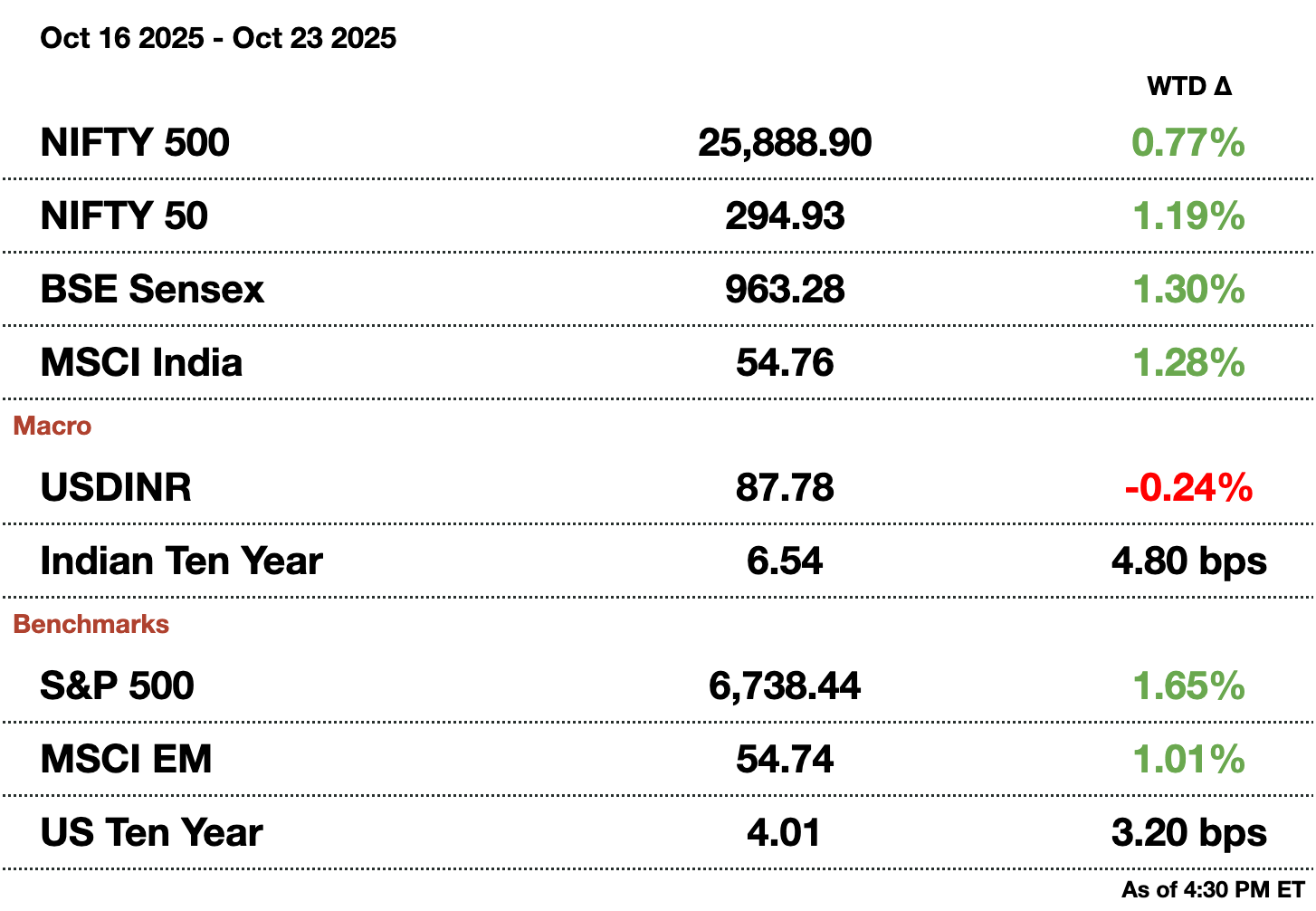- Samosa Capital
- Posts
- 📰Modi Skips Trump Meeting | Daily India Briefing
📰Modi Skips Trump Meeting | Daily India Briefing
Three stories on Indian markets that you can't miss.


Today’s deep dives: Global investors are pouring money into Indian government bonds after the RBI’s aggressive defense of the rupee. U.S. sanctions on Russian oil companies hurt India’s oil supply. Modi will skip ASEAN summit, missing face-to-face meeting with Trump.
We want to talk to you! Just respond to this email and we’ll set up a time to learn more about how Samosa Capital can be more helpful in your work.
If you have any questions about India, fill out this form or reach out to Shreyas at [email protected]



Macro
Indian equities resumed post-Diwali trading with commodities and trade talks in focus as oil surged following new U.S. sanctions on Russia. Investors are eyeing progress on a potential U.S.-India trade deal, while pricier crude pressures refiners and AI disruption weighs on tech sentiment.
Real yields across emerging Asia have surged to multi-year highs even as nominal rates ease, making regional bonds increasingly attractive to investors. With inflation cooling, especially in India and the Philippines, analysts see scope for rate cuts and opportunities in short-term debt.
Equities
Hindustan Unilever posted a profit uptick driven largely by robust demand for beauty and personal-care products, especially in rural markets. The company cited improving consumption patterns despite broader macroeconomic pressures.
Colgate‑Palmolive India posted a profit drop of around 17 percent in its latest quarter, citing disruptions caused by tax-cut announcements that unsettled sales momentum. Weak urban demand and heightened competition further weighed on its performance in a challenging FMCG climate.
India’s largest two-wheeler maker, Hero MotoCorp, has signed a deal with UK distributor MotoGB to launch Euro 5+ models in the United Kingdom, marking its 51st international market. The move strengthens Hero’s footprint in Europe amid domestic market headwinds
Alts
Gold rebounded 1.2 percent after sharp losses earlier in the week, with prices stabilizing above $4,000 (₹351,000) amid continued safe-haven demand. Despite ETF outflows and cooling speculative fervor, the metal remains up 55 percent this year, fueled by rate-cut bets and “debasement trade” optimism.
Policy
India approved $9 billion (₹790.3 billion) in new defense purchases to modernize its armed forces, including missile systems, naval guns, and high-mobility vehicles. The acquisitions underscore New Delhi’s accelerating military buildup amid rising regional security challenges and its continued emphasis on domestic defense production.
India’s government trimmed the number of officials authorised to order social-media content removals after a public clash with X. The new protocol restricts takedown requests to senior bureaucrats and top police officials, aiming to balance regulation and free-speech concerns.

But what can you actually DO about the proclaimed ‘AI bubble’? Billionaires know an alternative…
Sure, if you held your stocks since the dotcom bubble, you would’ve been up—eventually. But three years after the dot-com bust the S&P 500 was still far down from its peak. So, how else can you invest when almost every market is tied to stocks?
Lo and behold, billionaires have an alternative way to diversify: allocate to a physical asset class that outpaced the S&P by 15% from 1995 to 2025, with almost no correlation to equities. It’s part of a massive global market, long leveraged by the ultra-wealthy (Bezos, Gates, Rockefellers etc).
Contemporary and post-war art.
Masterworks lets you invest in multimillion-dollar artworks featuring legends like Banksy, Basquiat, and Picasso—without needing millions. Over 70,000 members have together invested more than $1.2 billion across over 500 artworks. So far, 23 sales have delivered net annualized returns like 17.6%, 17.8%, and 21.5%.*
Want access?
Investing involves risk. Past performance not indicative of future returns. Reg A disclosures at masterworks.com/cd
Reach out to [email protected] to reach our audience and see your advertisement here.

1. Foreign Investors Flock to Indian Bonds

Global investors are pouring money into Indian government bonds after the RBI’s aggressive defense of the rupee restored confidence in the country’s markets.
Foreign purchases of rupee-denominated debt surged 46-fold last week to $631 million (₹55.5 billion), according to data from the Clearing Corporation of India. The move came as the RBI intervened heavily in both offshore and onshore markets to halt the rupee’s slide, pushing the currency up nearly 1 percent and reducing volatility to year lows.
India’s 10-year bond yields, hovering near 6.5 percent, now offer some of the most attractive returns among major emerging markets. Combined with a firmer rupee, these high yields have made Indian debt increasingly appealing to foreign portfolio managers seeking stability and carry income.
“The rupee’s stabilization is a strong signal,” said Yifei Ding of Invesco Hong Kong, noting that an appreciating currency enhances returns for global investors.
So far in October, Indian bonds have returned 1.9 percent, outperforming the broader emerging market index. Analysts expect further inflows as inflation eases and speculation builds over potential rate cuts later this year.
Still, sentiment remains sensitive to trade tensions and U.S. tariffs. A renewed bout of rupee weakness or retreat by the central bank could test this rally — but for now, India’s bond market looks firmly back in favor.
2. US Oil Sanctions on Russia Impacting India

Washington’s latest sanctions on Russian oil giants Rosneft and Lukoil have thrown India’s energy calculus into turmoil. The move, which effectively ends Russian oil imports to India, comes after months of mounting pressure from the U.S. to curb purchases from Moscow.
The U.S. Treasury, under Trump’s order, designated Rosneft and Lukoil (and dozens of their subsidiaries) as blocked entities under Executive Order 14024. This effectively cut them off from the global financial system, freezing any assets tied to the U.S. and banning all American and allied transactions with the companies.
Flows from Russia, which made up 36 percent of India’s oil imports this year, are now expected to plunge to near zero as Indian refiners unwind transactions before the November 21 deadline. State-run firms like Indian Oil, Bharat Petroleum, and Hindustan Petroleum, along with Reliance Industries, are now scrambling to secure alternative supplies from the Middle East and Africa.
The shift marks a dramatic reversal of a three-year trade boom that began when India capitalized on discounted Russian barrels following the Ukraine war. The Kremlin’s crude had become a cornerstone of India’s refining economy, feeding Jamnagar and other coastal complexes while cushioning domestic fuel prices.
But the U.S. move to blacklist Moscow’s top producers signals a new phase of energy weaponization, one that may push India closer to Gulf suppliers while complicating its diplomatic balancing act. Refiners expect costs to rise as they compete for Middle Eastern grades already in high demand from Europe and China.
While India avoided such sanctions before, the latest escalation underscores how global energy realignments are increasingly leaving few neutral paths. For New Delhi, the era of easy Russian crude may have just ended.
3. Modi to Skip ASEAN Summit, Missing Trump Meeting

Modi and Trump in 2019
Modi will skip the ASEAN summit in Kuala Lumpur next week, opting to attend virtually amid Diwali celebrations — a move that also means missing a potential face-to-face meeting with Donald Trump at a critical moment in trade talks.
Malaysian Prime Minister Anwar Ibrahim confirmed that Modi had informed him of the decision in a phone call, saying he “respected” the choice and extended festive greetings to India. Modi acknowledged the conversation in a post on X but gave no reason for skipping the trip.
The timing is sensitive: Washington recently imposed a 50 percent tariff on Indian goods as part of its pressure campaign over New Delhi’s purchases of Russian oil. Trump said earlier this week that Modi assured him India would reduce those imports — though Indian officials have not confirmed such a pledge.
The absence of an in-person meeting could delay momentum toward a deal. Both governments have been negotiating to unwind tariffs and reset trade ties, which have soured under the new U.S. measures. Officials say talks are progressing, but the latest U.S. sanctions on Rosneft and Lukoil have made India’s energy calculus even more complex.
External Affairs Minister S. Jaishankar is expected to represent India at the summit. Modi’s virtual presence underscores how domestic priorities and the U.S. sanctions fallout are shaping India’s diplomatic calendar.
How helpful was today's newsletter? |
See you tomorrow.
Written by Eshaan Chanda & Yash Tibrewal. Edited by Shreyas Sinha.
Sponsor the next newsletter to reach tens of thousands of U.S.-based business-savvy professionals. Reach out to [email protected].
Could your business use expert insights to power growth in India? Reach out to [email protected] for a free introductory call.
Disclaimer: This is not financial advice or recommendation for any investment. The Content is for informational purposes only, you should not construe any such information or other material as legal, tax, investment, financial, or other advice.
